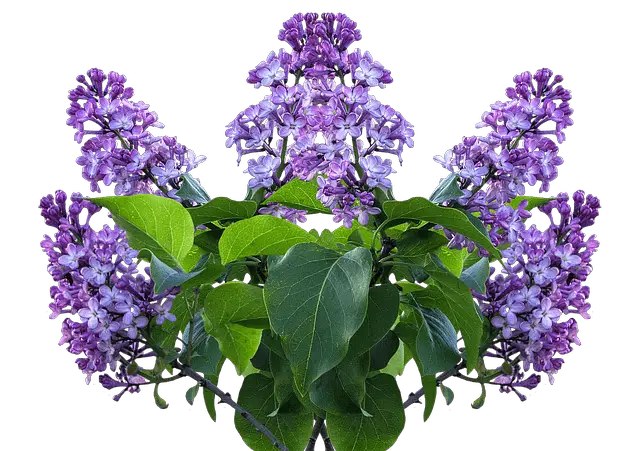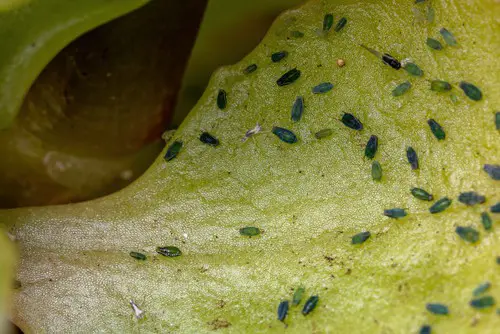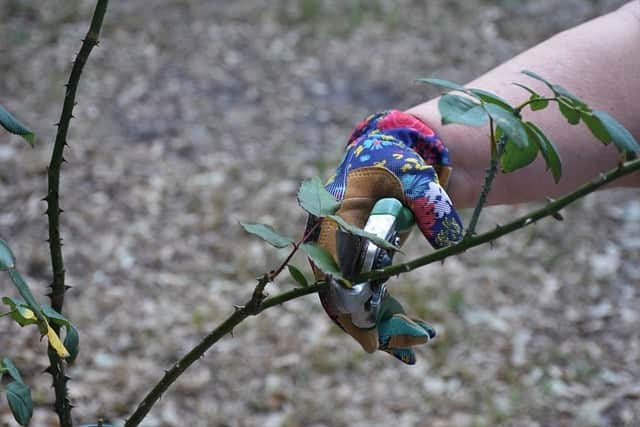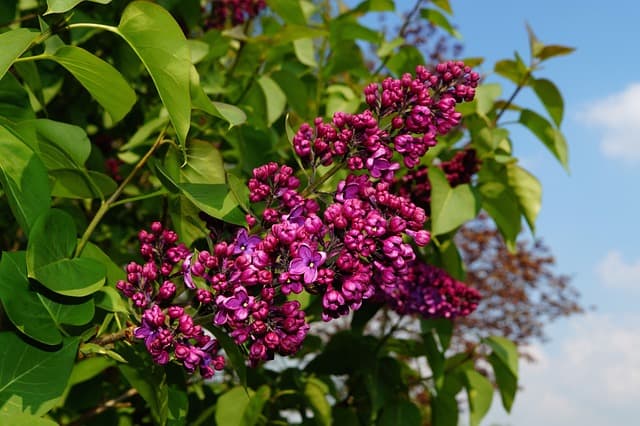Lilacs are a popular ornamental plant known for their fragrant blooms and attractive foliage. However, lilac leaves turning yellow can be a sign of an underlying issue. While some yellowing may be normal, excessive yellowing and browning can indicate a problem with the plant’s health.
Understanding the lilac plant is important when dealing with yellowing leaves. Lilacs prefer well-drained soil and full sunlight, but they can thrive in a range of conditions.
Overwatering, nutrient deficiencies, pests, and diseases can all cause yellowing leaves. Additionally, weather conditions and sunlight exposure can impact the health of lilacs. By identifying the cause of yellowing leaves, gardeners can take steps to restore the health of their lilac bushes.
Key Takeaways
- Yellowing leaves on lilac bushes can be a sign of an underlying issue.
- Lilacs prefer well-drained soil and full sunlight, but they can thrive in a range of conditions.
- Overwatering, nutrient deficiencies, pests, and diseases can all cause yellowing leaves on lilacs.
Also don’t miss:
- Leyland Cypress Turning Yellow
- Lettuce Leaves Turning Yellow
- Dipladenia Leaves Turning Yellow and Falling Off
Understanding the Lilac Plant

Lilacs are deciduous shrubs or small trees that belong to the olive family. They are known for their fragrant flowers that bloom in spring or early summer and come in various colors such as purple, pink, white, and blue.
The most commonly planted species is Syringa vulgaris, but there are also other species such as S. reticulata and many cultivars.
Lilacs can grow up to 20 feet tall and wide, but most commonly reach 8 to 12 feet in height and spread. They prefer full sun and well-drained soil, but can tolerate some shade and different types of soil. They are hardy plants that can survive in USDA zones 3 to 7.
The leaves of the lilac plant are opposite, meaning they grow in pairs on the stem, and are heart-shaped or oval-shaped with a pointed tip. They are typically green, but can turn yellow for various reasons. Lilac leaves can also be affected by pests and diseases such as powdery mildew, leaf miners, and borers.
To keep lilac plants healthy and blooming, it is important to prune them regularly, fertilize them with a balanced fertilizer in spring, and water them deeply during dry periods.
Overwatering or underwatering can cause stress to the plant and lead to yellowing leaves. Lilacs also benefit from mulching to retain moisture and suppress weeds.
Common Symptoms of Unhealthy Lilac Leaves
When lilac leaves begin to turn yellow, it can be a sign of a problem. There are many reasons why lilac leaves may turn yellow, including pests, diseases, and environmental factors. Here are some common symptoms of unhealthy lilac leaves:
- Yellow leaves: Yellowing leaves are one of the most common symptoms of unhealthy lilac leaves. This can be caused by a variety of factors, including nutrient deficiencies, pests, and diseases.
- Browning leaves: Browning leaves can also be a sign of a problem. This can be caused by pests, diseases, or environmental factors such as drought or extreme temperatures.
- Wilting: Wilting is another common symptom of unhealthy lilac leaves. This can be caused by a lack of water or nutrients, or by pests or diseases.
- Leaf drop: If your lilac leaves are dropping prematurely, it could be a sign of a problem. This can be caused by pests, diseases, or environmental factors.
- Deformed leaves: Deformed leaves can be caused by pests or diseases. This can include distorted or curled leaves, or leaves with holes or spots.
- Pale green: If your lilac leaves are a pale green color, it could be a sign of a nutrient deficiency.
- Leaves drooping: Drooping leaves can be caused by a lack of water or nutrients, or by pests or diseases.
- Gray mold spots: Gray mold spots on lilac leaves can be a sign of a fungal infection. This can be caused by environmental factors such as high humidity or by pests or diseases.
- Turning brown: Brown leaves can be caused by a variety of factors, including pests, diseases, and environmental factors such as drought or extreme temperatures.
If you notice any of these symptoms on your lilac leaves, it is important to take action to address the problem. Identifying the cause of the problem is the first step in finding a solution.
Role of Watering in Lilac Health

Watering is a crucial aspect of maintaining the health of lilac bushes. Both overwatering and underwatering can cause the leaves of lilac bushes to turn yellow and eventually die. Therefore, it is important to understand the role of watering in lilac health and how to water them properly.
Overwatering is one of the most common reasons for yellowing leaves on lilac bushes. When the soil is too moist, the roots of the plant cannot get enough oxygen, which can lead to root rot.
This condition can cause the leaves to turn yellow, wilt, and eventually die. To avoid overwatering, it is important to water the plant occasionally and not too frequently.
On the other hand, underwatering can also cause the leaves to turn yellow. Lack of water can dry out the plant, turning its leaves yellow and brown until they fall off. To prevent this, it is important to water the plant regularly, especially during hot and dry weather.
The frequency of watering depends on several factors, including the climate, soil moisture, and the size of the plant. Lilac bushes prefer well-draining soil and can suffer from moisture stress if the soil is too wet or too dry. Therefore, it is important to check the soil moisture regularly and adjust the watering frequency accordingly.
If the lilac bush is planted in a pot, it is important to ensure that the pot has drainage holes. This allows excess water to drain out and prevents the roots from sitting in water, which can cause root rot. In case of flooding or heavy rainfall, it is important to remove any standing water around the plant to prevent waterlogging.
Impact of Weather and Sunlight
Yellowing leaves on lilac bushes can also be caused by environmental factors such as weather and sunlight. Lilacs prefer cool and moist weather, and prolonged exposure to tropical temperatures can cause the leaves to turn yellow.
During the spring, lilacs require ample water to support new growth and the development of flower buds. A lack of water during this time can cause leaves to yellow and fall off.
Rain and storms can also impact the health of lilac bushes. Heavy rain can cause the soil to become waterlogged, leading to root rot and yellowing leaves. Windy storms can damage the leaves and branches, making the plant more susceptible to disease and pests.
Direct sunlight can also cause lilac leaves to turn yellow. While lilacs require sunlight to grow and thrive, too much direct sunlight can cause sunburn and yellowing of the leaves. This is particularly true for younger plants that have not yet developed a strong root system.
To prevent yellowing leaves caused by sunlight, it is important to plant lilacs in an area that receives partial shade. If the plant is already established in an area with too much direct sunlight, it may be necessary to prune back some of the branches to provide more shade.
Nutrient Deficiencies in Lilacs

Lilacs are beautiful and fragrant shrubs that can bring color and life to any garden. However, when their leaves start to turn yellow, it can be a sign of a nutrient deficiency. Nutrient deficiencies can be caused by a variety of factors, including soil pH, poor soil quality, or inadequate fertilization.
In this section, we will explore some of the most common nutrient deficiencies that can cause yellowing leaves in lilacs.
1. Iron Deficiency
Iron deficiency is a common cause of yellowing leaves in lilacs. This can occur when the soil pH is too high, making it difficult for the plant to absorb iron. Symptoms of iron deficiency include yellowing leaves with green veins. To treat iron deficiency, gardeners can apply iron sulfate to the soil or use a fertilizer that contains iron.
2. Nitrogen Deficiency
Nitrogen deficiency can also cause yellowing leaves in lilacs. Nitrogen is an essential nutrient for plant growth, and a lack of it can cause stunted growth and yellowing leaves.
Symptoms of nitrogen deficiency include yellowing leaves that start at the base of the plant and move upward. To treat nitrogen deficiency, gardeners can use a fertilizer that contains nitrogen or add organic matter to the soil.
3. Magnesium Deficiency
Magnesium is another essential nutrient for plant growth, and a lack of it can cause yellowing leaves in lilacs. Symptoms of magnesium deficiency include yellowing leaves with green veins and brown spots. To treat magnesium deficiency, gardeners can apply a fertilizer that contains magnesium or use Epsom salts.
4. Sulfur Deficiency
Sulfur deficiency can also cause yellowing leaves in lilacs. Symptoms of sulfur deficiency include yellowing leaves with green veins and stunted growth. To treat sulfur deficiency, gardeners can use a fertilizer that contains sulfur or add organic matter to the soil.
5. Potassium Insufficiency
Potassium is an essential nutrient for plant growth, and a lack of it can cause yellowing leaves in lilacs. Symptoms of potassium insufficiency include yellowing leaves that start at the tips and edges of the plant and move inward.
To treat potassium insufficiency, gardeners can use a fertilizer that contains potassium or add organic matter to the soil.
Diseases and Pests Affecting Lilacs

Lilacs are prone to several diseases and pests that can cause the leaves to turn yellow. Here are some of the common diseases and pests that can affect lilacs:
- Fungal Diseases: Fungal diseases like gray mold and verticillium wilt can cause the leaves of lilacs to turn yellow. Gray mold is caused by the fungus Botrytis cinerea, and it can cause the leaves to become brown and wilted. Verticillium wilt is caused by the fungus Verticillium dahliae, and it can cause the leaves to turn yellow and wilted.
- Bacterial Diseases: Bacterial diseases like lilac pseudocercospora leaf spot can cause the leaves of lilacs to turn yellow. Lilac pseudocercospora leaf spot is caused by the bacteria Pseudocercospora syringae, and it can cause the leaves to develop small, dark spots that eventually turn yellow and fall off.
- Insects and Pests: Insect infestations like the lilac borer can cause the leaves of lilacs to turn yellow. The lilac borer is a type of beetle that lays its eggs on the bark of lilac branches, and the larvae bore into the branches, causing damage and weakening the plant. Other pests like aphids and spider mites can also cause the leaves to turn yellow.
- Fungal Infections: Fungal infections like powdery mildew can cause the leaves of lilacs to turn yellow. Powdery mildew is a fungal disease that causes a white, powdery growth on the leaves, stems, and flowers of plants. It can also cause the leaves to become distorted and turn yellow.
- Pathogens: Pathogens like phytoplasmas can cause the leaves of lilacs to turn yellow. Phytoplasmas are bacteria-like organisms that live in the phloem of plants, and they can cause a variety of symptoms, including yellowing of the leaves.
To prevent these diseases and pests, it is important to keep the lilac plant healthy by watering it regularly, fertilizing it appropriately, and pruning it regularly. If an infestation or infection does occur, it is important to treat it as soon as possible to prevent further damage to the plant.
Lilac Care and Maintenance
Lilacs are hardy, low-maintenance shrubs that can thrive in a variety of soil types and climates. Proper care and maintenance can help prevent yellowing leaves and other issues that may affect the health and appearance of your lilac shrubs.
1. Pruning

Pruning is an essential part of lilac care. It not only helps to maintain the shape and size of the shrub but also promotes healthy growth and flowering. Renewal pruning is recommended every few years to remove old, woody stems and encourage new growth. This involves cutting back one-third of the oldest stems at the base of the shrub.
2. Plant Care
Lilacs prefer well-drained soil and full sun exposure. They should be watered deeply and regularly during dry periods, but overwatering should be avoided as it can lead to yellowing leaves and root rot. Fertilizing once a year, in early spring, can help promote healthy growth and flowering.
3. Root Systems
Lilacs have shallow root systems that can be easily damaged by digging or planting too close to the shrub. It is important to avoid disturbing the roots when planting or landscaping around the shrub. Mulching around the base of the shrub can help retain moisture and protect the roots from extreme temperatures.
4. Established Shrubs
Established lilac shrubs require minimal care and maintenance. However, it is important to monitor for signs of branch dieback, which can be caused by disease, pests, or environmental factors. Yellowing leaves can be a sign of stress or nutrient deficiencies, and should be addressed promptly to prevent further damage.
Professional Help for Lilac Issues
If the yellowing of lilac leaves persists despite the home remedies, it may be time to call in a professional for help. A certified arborist or an Extension Master Gardener can help diagnose the problem and provide appropriate solutions to save the lilac bush.
A certified arborist is a professional who specializes in tree care and maintenance. They are trained to identify and treat various diseases and pests that can affect trees, including lilacs. They can also provide guidance on pruning and fertilization to help promote healthy growth.
Extension Master Gardeners are trained volunteers who provide gardening advice and education to the public. They are often associated with local universities or cooperative extension offices and can provide information on a wide range of gardening topics, including lilac care.
They may also be able to refer you to a local plant disease clinic for further assistance.
The UMN Plant Disease Clinic is a diagnostic laboratory that specializes in identifying plant diseases and pests. They can analyze samples of lilac leaves and provide a diagnosis of the problem. They can also provide recommendations for treatment and prevention of future problems.
It is important to note that professional help may come at a cost, but it may be worth it if the lilac bush is valuable or sentimental. It is also important to choose a reputable professional with experience in lilac care to ensure that the problem is properly diagnosed and treated.
Dealing with Unhealthy Lilacs

Lilac leaves turning yellow can be a sign of an unhealthy plant. If you notice your lilac leaves turning yellow, it is important to take action to prevent the spread of the issue. Here are some possible causes of unhealthy lilacs and some steps you can take to address them:
1. Root Rot
Overwatering can lead to root rot, which can cause yellowing leaves. If the soil around your lilac is constantly wet, it may be a sign of overwatering. To address root rot, you can try to improve drainage by adding organic matter to the soil or by planting in a raised bed. If the roots are already damaged, you may need to replace the plant.
2. Herbicide Damage
Lilacs can be sensitive to herbicides, which can cause yellowing leaves. If you suspect herbicide damage, try to identify the source of the herbicide and remove it from the area. You can also try to flush the soil with water to remove any remaining herbicide.
3. Biotic Causes
Fungal diseases such as Pseudocercospora leaf spot and powdery mildew can cause yellowing leaves on lilacs. To prevent the spread of fungal diseases, remove any infected leaves and prune the plant to improve air circulation. You can also try using a fungicide to treat the plant.
4. Abiotic Causes
Yellowing leaves can also be caused by environmental factors such as nutrient deficiencies or extreme temperatures. To address nutrient deficiencies, you can add fertilizer to the soil. To protect the plant from extreme temperatures, you can provide shade or cover the plant during extreme weather conditions.
5. Sanitation
Sanitation is key to preventing the spread of any disease. Make sure to remove any dead or diseased leaves from the plant and dispose of them properly. You can also sterilize your pruning tools between uses to prevent the spread of disease.
6. Property and Sentimental Value
Lilacs can have both property and sentimental value, so it is important to take care of them. An unhealthy lilac can decrease property value, and sentimental value can be lost if the plant dies. Taking proactive steps to maintain the health of your lilac can help preserve both types of value.
7. Replacements
If your lilac is beyond saving, it may be time to consider a replacement. When selecting a replacement plant, consider the growing conditions of your garden and choose a plant that is well-suited to those conditions.
8. Sterile Potting Soil
When planting a new lilac, it is important to use sterile potting soil. This can help prevent the introduction of disease to the plant.
Frequently Asked Questions

Why are the leaves on my lilac bush turning yellow?
Yellowing leaves on a lilac bush can be caused by a variety of factors, including overwatering, poor soil conditions, pests, diseases, and nutrient deficiencies.
How can I prevent my lilac leaves from turning yellow?
To prevent lilac leaves from turning yellow, it is important to ensure that the plant is growing in well-draining soil and is not being overwatered. Additionally, regular fertilization can help ensure that the plant is receiving the necessary nutrients to stay healthy.
What is causing my lilac leaves to turn yellow and curl?
Yellowing and curling leaves on a lilac bush can be a sign of a fungal or bacterial infection. These infections can be caused by a variety of factors, including poor soil conditions, overwatering, and lack of proper air circulation.
Is overwatering causing my lilac leaves to turn yellow?
Overwatering can be a common cause of yellowing leaves on a lilac bush. When the plant is overwatered, the roots can become waterlogged and suffocated, leading to a lack of oxygen and nutrient uptake.
What are some common diseases that cause lilac leaves to turn yellow?
Some common diseases that can cause lilac leaves to turn yellow include powdery mildew, verticillium wilt, and bacterial blight. These diseases can be caused by a variety of factors, including poor soil conditions, lack of proper air circulation, and overwatering.
How can I treat my lilac bush if the leaves are turning yellow?
Treatment for yellowing leaves on a lilac bush will depend on the underlying cause. In some cases, simply adjusting watering habits or improving soil conditions may be enough to resolve the issue.
In other cases, fungicides or other treatments may be necessary to control the spread of disease. It is important to properly diagnose the issue before attempting any treatment.

Hey, I’m Lisa and I’ve been an avid gardener for over 30 years. I love writing, talking and living in the garden! Feel free to connect with me on my socials below

